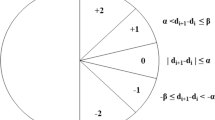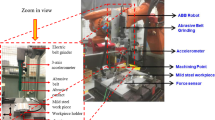Abstract
Tool wear monitoring is deemed as an essential technology of the intelligent manufacturing to guarantee the processing quality and improve the machining efficiency. In this paper, a prediction model based on adaptive particle swarm optimization (APSO) algorithm and least squares support vector machine (LS-SVM) algorithm is proposed for the recognition of drill wear. Cutting force signal and vibration signal are used for tool wear monitoring. And these signals are preprocessed through wavelet threshold de-noising algorithm. Multiple signal feature extraction methods are carried out to process the sample data related to drill wear status. The mean absolute error of the tool wear recognition model is 0.91%, better than the standard LS-SVM algorithm under the same condition.











Similar content being viewed by others
References
Liu MK, Tseng YH, Tran MQ (2019) Tool wear monitoring and prediction based on sound signal. Int J Adv Manuf Technol 103(1–4):3361–3373. https://doi.org/10.1007/s00170-019-03686-2
Aghazadeh F, Tahan A, Thomas M (2018) Tool condition monitoring using spectral subtraction and convolutional neural networks in milling process. Int J Adv Manuf Technol 98(9–12):3217–3227. https://doi.org/10.1007/s00170-018-2420-0
Xie Z, Li J, Lu Y (2019) Feature selection and a method to improve the performance of tool condition monitoring. Int J Adv Manuf Technol 100(9–12):3197–3206. https://doi.org/10.1007/s00170-018-2926-5
Nouri M, Fussell BK, Ziniti BL, Linder E (2015) Real-time tool wear monitoring in milling using a cutting condition independent method. Int J Mach Tools Manuf 89:1–13. https://doi.org/10.1016/j.ijmachtools.2014.10.011
Towsyfyan H, Gu F, Ball AD, Liang B (2018) Modelling acoustic emissions generated by tribological behaviour of mechanical seals for condition monitoring and fault detection. Tribol Int 125:46–58. https://doi.org/10.1016/j.triboint.2018.04.021
Hocheng H, Tseng HC, Hsieh ML, Lin YH (2018) Tool wear monitoring in single-point diamond turning using laser scattering from machined workpiece. J Manuf Process 31:405–415. https://doi.org/10.1016/j.jmapro.2017.12.007
Ambhore N, Kamble D, Chinchanikar S, Wayal V (2015) Tool condition monitoring system: a review. Mater Today: Proc 2:3419–3428
Shi C, Panoutsos G, Luo B, Liu H, Li B (2019) Using multiple-feature-spaces-based deep learning for tool condition monitoring in ultraprecision manufacturing. IEEE Trans Ind Electron 66:3794–3803. https://doi.org/10.1109/tie.2018.2856193
Jantunen E (2002) A summary of methods applied to tool condition monitoring in drilling. Int J Mach Tools Manuf 42(9):997–1010. https://doi.org/10.1016/s0890-6955(02)00040-8
Klaic M, Murat Z, Staroveski T, Brezak D (2018) Tool wear monitoring in rock drilling applications using vibration signals. Wear 408:222–227. https://doi.org/10.1016/j.wear.2018.05.012
Abu-Mahfouz I, Banerjee A (2014) Drill wear feature identification under varying cutting conditions using vibration and cutting force signals and data mining techniques. Proc Comput Sci 36:556–563. https://doi.org/10.1016/j.procs.2014.09.054
Bhuiyan MSH, Choudhury IA, Dahari M (2014) Monitoring the tool wear, surface roughness and chip formation occurrences using multiple sensors in turning. J Manuf Syst 33:476–487. https://doi.org/10.1016/j.jmsy.2014.04.005
Jauregui JC, Resendiz JR, Thenozhi S, Szalay J, Jacso A, Takacs M (2018) Frequency and time-frequency analysis of cutting force and vibration signals for tool condition monitoring. IEEE Access 6:6400–6410. https://doi.org/10.1109/access.2018.2797003
Rafezi H, Akbari J, Behzad M (2012) Tool condition monitoring based on sound and vibration analysis and wavelet packet decomposition. 2012 8th International Symposium on Mechatronics and its Applications :1-4. https://doi.org/10.1109/isma.2012.6215170
Cao H, Lei Y, He Z (2013) Chatter identification in end milling process using wavelet packets and Hilbert–Huang transform. Int J Mach Tools Manuf 69:11–19. https://doi.org/10.1016/j.ijmachtools.2013.02.007
Salgado DR, Alonso FJ (2007) An approach based on current and sound signals for in-process tool wear monitoring. Int J Mach Tools Manuf 47:2140–2152. https://doi.org/10.1016/j.ijmachtools.2007.04.013
Chan FTS, Swarnkar R (2006) Ant colony optimization approach to a fuzzy goal programming model for a machine tool selection and operation allocation problem in an FMS. Robot Comput Integr Manuf 22:353–362. https://doi.org/10.1016/j.rcim.2005.08.001
Panigrahi BK, Bijaya K, Shi YH, Lim MH (2011) Handbook of swarm intelligence: concepts, principles and applications. Springer Science & Business Media
Karaboga D, Akay B (2009) A survey: algorithms simulating bee swarm intelligence. Artif Intell Rev 31:61–85. https://doi.org/10.1007/s10462-009-9127-4
García-Nieto PJ, García-Gonzalo E, Vilán JAV, Robleda AS (2016) A new predictive model based on the PSO-optimized support vector machine approach for predicting the milling tool wear from milling runs experimental data. Int J Adv Manuf Technol 86:769–780. https://doi.org/10.1007/s00170-015-8148-1
Meena A, El Mansori M (2013) Specific cutting force, tool wear and chip morphology characteristics during dry drilling of austempered ductile iron (ADI). Int J Adv Manuf Technol 69:2833–2841. https://doi.org/10.1007/s00170-013-5220-6
Liang X, Liu Z (2018) Tool wear behaviors and corresponding machined surface topography during high-speed machining of Ti-6Al-4V with fine grain tools. Tribol Int 121:321–332. https://doi.org/10.1016/j.triboint.2018.01.057
Zhang L, Qin H, Yu C (2008) Reseach of denoising method based on wavelet threshold. Comput Eng Appl 44(9):172–173
Cui H, Zhao R, Hou Y (2012) Improved threshold denoising method based on wavelet transform. Phys Procedia 33:1354–1359. https://doi.org/10.1016/j.phpro.2012.05.222
Noori-Khajavi A, Komanduri R (1995) Frequency and time domain analyses of sensor signals in drilling—I. Correlation with drill wear. Int J Mach Tools Manuf 35:775–793. https://doi.org/10.1016/0890-6955(94)00060-w
El-Wardany TI, Gao D, Elbestawi MA (1996) Tool condition monitoring in drilling using vibration signature analysis. Int J Mach Tools Manuf 36:687–711. https://doi.org/10.1016/0890-6955(95)00058-5
Newland DE (1993) Harmonic wavelet analysis. Proc: Math Phys Sci 443:203–225
Hwang HJ, Park HC (2014) Evaluation of condition of gravel ballast layer on high-speed railway using surface wave method based on harmonic wavelet analysis of waves. NDT E Int 68:78–87. https://doi.org/10.1016/j.ndteint.2014.08.005
Zhang J, Starly B, Cai Y, Cohen PH, Lee YS (2017) Particle learning in online tool wear diagnosis and prognosis. J Manuf Process 28:457–463. https://doi.org/10.1016/j.jmapro.2017.04.012
Zhan Z, Zhang J, Li Y, Chung HSH (2009) Adaptive particle swarm optimization. IEEE Transact Cybern 39:1362–1381
Li W, Fu P, Zhang E (2014) Application of particle swarm optimization-least square support vector machine in tool wear monitoring. Appl Res Comput 4:34
Hsieh HT, Chu CH (2013) Improving optimization of tool path planning in 5-axis flank milling using advanced PSO algorithms. Robot Comput Integr Manuf 29:3–11. https://doi.org/10.1016/j.rcim.2012.04.007
Funding
This work was supported by the NSFC of China (No. 51975288, No. 51905270) and NSF of Jiangsu Province (No. BK20180435).
Author information
Authors and Affiliations
Corresponding author
Additional information
Publisher’s note
Springer Nature remains neutral with regard to jurisdictional claims in published maps and institutional affiliations.
Highlights
• The model based on APSO-LS-SVM is established to recognize the tool wear.
• Cutting force signal and vibration signal were used for tool wear detection.
• Wavelet threshold de-noising method was selected to preprocess the signals.
• Time, frequency domain and harmonic wavelet packet analysis are implemented.
Rights and permissions
About this article
Cite this article
Chen, N., Hao, B., Guo, Y. et al. Research on tool wear monitoring in drilling process based on APSO-LS-SVM approach. Int J Adv Manuf Technol 108, 2091–2101 (2020). https://doi.org/10.1007/s00170-020-05549-7
Received:
Accepted:
Published:
Issue Date:
DOI: https://doi.org/10.1007/s00170-020-05549-7




